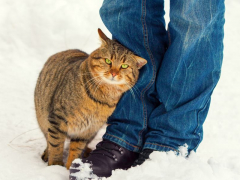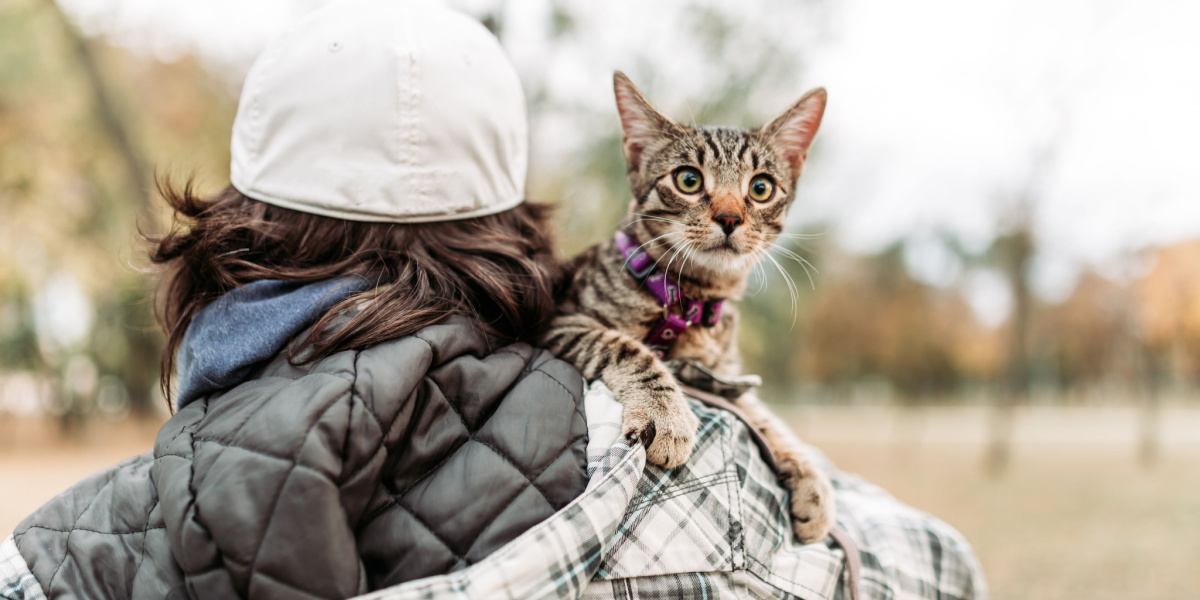
There is a widely believed stereotype that cats are aloof, merely tolerate their human companions, and interact strictly on their own feline terms. Many cat owners disagree strongly with this, and research has demonstrated that cats do miss their owners when they are left alone and that they can form strong attachments to people.
Some cats take this bonding even further, and actively demand attention from their owners, with some cats even loving being picked up and carried around. In this article, we will look into why some cats enjoy being carried by their owners while others don‘t, issues to be aware of, and if there are any breeds more likely to enjoy this than others.
Some cats love being carried by their owners, and this might be related to cats' instinctive desire to be high up like their wildcat relatives. Certain breeds and cats that received positive early socialization experiences might be more likely to enjoy being carried. Some cats just don’t like being carried—it's important to respect this and interact on their own terms by sitting close to them, petting them, and grooming them.Key Takeaways
Why Do Cats Like To Be High?

Like their wildcats relatives, domestic cats like being up high, which allows them to survey the area and feel safe.
Domestic cats (Felis catus) are part of the Felidae family, which contains 37 recognized species including lions, tigers, cheetahs, and several wildcats, all thought to have evolved from a common ancestor in Asia 10 to 12 million years ago. DNA samples from pet cats across the globe have been shown to be nearly identical to the DNA of the African wildcat (Felis sylvestris lybica), which still lives in Asia and North Africa today.
The answer to why some cats love being carried by their owners might lie in cats’ instinctive desire to be high up like their wildcat relatives:
- Being high up protects from ambushes from predators or other cats.
- Being high allows more time to assess threats or potentially dangerous situations.
- Elevation makes it easier to see prey for prime hunting opportunities.
- More dominant cats within a group tend to hang out in the highest spots.
- In our homes, getting off the ground makes it easier for cats to keep out of reach of other pets and people in the household (especially dogs and kids!).
Also Read: Cat Love Bites: 5 Reasons Why They Do It & How To Respond
Early Socialization Might Create Cats That Like To Be Carried
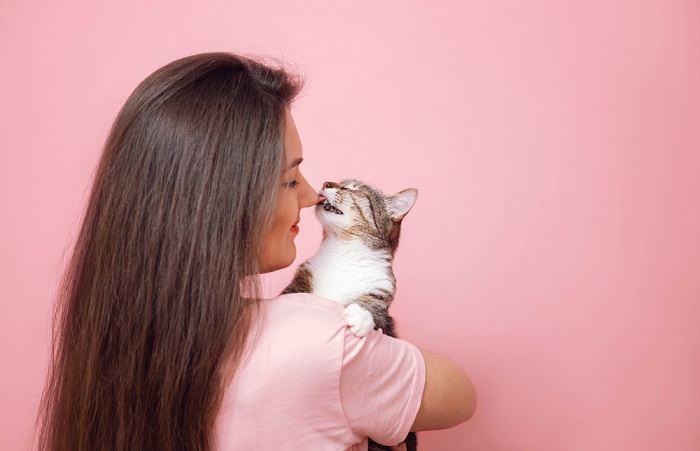
Kittens that are held a lot during the prime socialization window of 2 to 7 weeks of age often enjoy being carried as adults.
Although cats are individuals with unique personalities and preferences, there is a critical socialization period in their development as kittens that can affect how cats perceive situations and human contact for the rest of their lives.
The socialization period in cats is between 2 and 7 weeks of age, and any events or encounters within this time (positive or negative) affect whether they find the same experience threatening or not as an adult cat.
As well as being carried by the mother cat during their early life, kittens that are handled gently picked up, and carried daily by people during this time should accept it as being “normal” and safe as they mature.
This does not guarantee that all well-socialized cats will be keen to be carried as they get older, but it does explain why kittens with very little human contact during the socialization period, or feral cats, will be less likely to enjoy being carried (and might protest violently if you try).
If you are getting a kitten, speak to the breeder, rescue center, or person caring for the kittens to see what kind of human interaction they have had at a young age.
Also Read: Do Mother Cats Discipline Their Kittens? A Veterinarian Explains
Cat Breeds Most Likely To Enjoy Being Carried
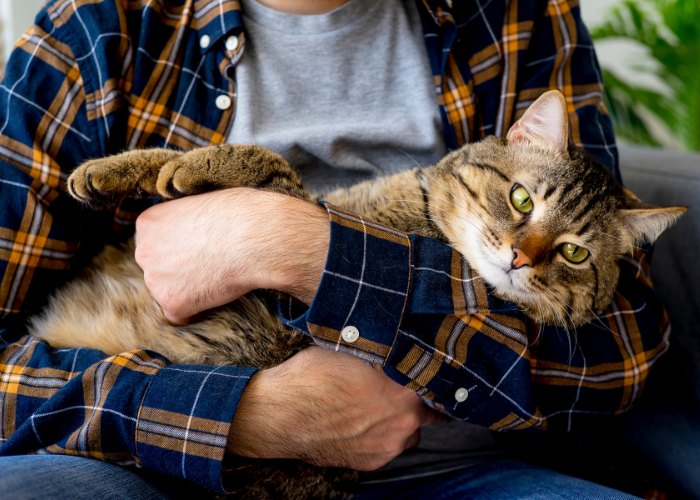
Some breeds are known for enjoying cuddles, but any cat of any breed might like being carried—or not.
Some breeds are particularly known for being friendly, affectionate, sociable, and enjoying close contact with people. Ragdoll cats have a reputation as lap cats, and usually enjoy being carried around cradled like a baby. In fact, the name Ragdoll is thought to come from their relaxed “floppy doll” appearance when they are picked up by people.
Studies have revealed that certain breeds appear to seek out human contact such as the Devon Rex and Korat. Other breeds such as the Siamese are known for being clingy, so it makes sense they might enjoy being carried.
On the other hand, breeds such as the fiercely independent Bengal, are less likely to enjoy feeling restrained by being carried. It is well worth remembering that there are always exceptions to every rule though, and other factors such as early socialization and individual personality will also play a role.
Also Read: Why Isn’t My Cat Affectionate?
Why Do Some Cats Fall Asleep While Being Carried?
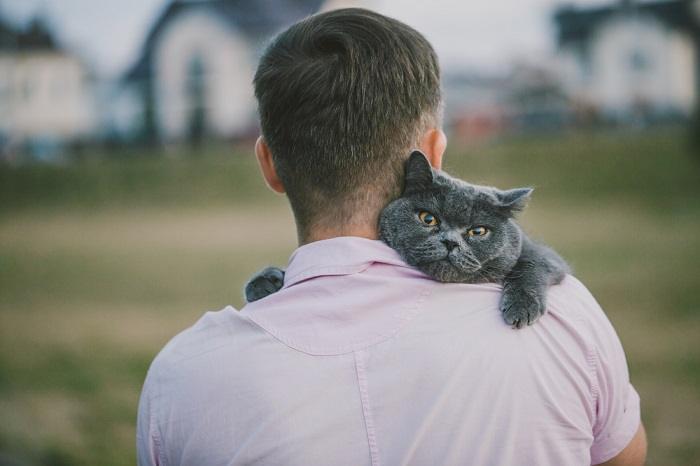
If your cat falls asleep in your arms, you can be sure they feel safe and comfortable in your presence.
As previously discussed, our domestic cats are very similar in their genetic makeup to their wildcat ancestors and share many of their instinctive behaviors. Wildcats are most vulnerable to attack by other animals (rivals or predators), when they are resting, so it might be that pet cats chose our arms to snooze in as a form of protection when they perceive they are at their most vulnerable.
Many people notice their cat loves to curl up in warm places such as sunny windowsills, or over hot-water pipes, so some cats might simply be taking advantage of the warmth from our bodies, and decide that being carried in their owner’s arms provides a safe, cozy sleeping spot.
Also Read: Why Do Cats Curl Into Balls When Sleeping? A Veterinarian Explains
Is It Safe To Carry My Cat Like A Baby?
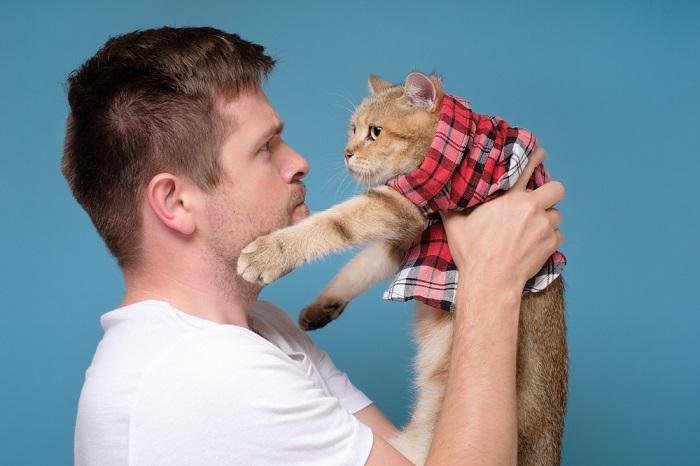
If your cat seems to like being held on their back like a baby, there is no harm in doing so.
It is usually recommended to carry your cat using both hands, fully supporting their legs to make them feel secure. Place one hand under their chest to support their body, whilst the other hand and arm cups their bottom and hind legs.
However, if your cat seems to enjoy being carried in your arms like a baby, enjoying belly rubs and purring away, then by all means indulge them! It is worth being cautious though, as their paws (armed with needle-sharp claws) will be near your face.
Cats are known for their changeable moods, so if they suddenly decide they aren’t happy with the situation you might end up being scratched on your face. Watch their body language for the first signs that they have had enough and want to get down, for instance, tail twitches, meows, or flattened ears.
Older cats are more likely to suffer from painful joint diseases such as osteoarthritis, which can affect their legs and spine. These cats might find being carried on their backs painful and be more prone to lashing out at you. Always consult your veterinarian if your notice your cat seems to be in pain or discomfort.
Also Read: 5 Reasons You Should Get A Second Cat (And 3 You Shouldn’t)
Why Doesn’t My Cat Like Being Carried?

Whether a cat enjoys being held and carried often comes down to their individual personality and preferences.
Some cats might not like being held or carried at all. It’s unnatural for cats to be picked up. Friendly communication between cats tends to involve head and body rubbing and bunting— not picking each other up. Many cats also object to the feeling of being restrained and not being able to easily get away from a situation. Here are some other potential reasons why your cat might not enjoy being carried:
- Lack of socialization: If kittens aren’t exposed to gentle handling and being picked up in their socialization period, they will be more likely to find this scary and stressful later on in life.
- Pain or fear: If the cat has been picked up without warning in the past and the experience was either painful or frightening, they will remember this and try to avoid being picked up again.
- Breed: Some breeds are less likely to want to be picked up and held than others (for example, Bengals).
- Personality: Many completely happy and healthy cats just do not like being picked up. Always let your cat guide you to the type of interaction and affection they enjoy.
If your cat used to enjoy being picked up and has now started to protest or avoid it, they might be in pain, so arrange a checkup with their veterinarian.
Also Read: 8 Ways To Help a Scared and Fearful Cat Be Confident
Final Thoughts

If your cat loves to be carried, count yourself lucky and enjoy the snuggles.
Cats love warm places to snuggle, and many cats enjoy being carried. Some cats even fully relax and have a nap in their owner‘s arms. Cats instinctively like high spots where they feel more safe and secure, so they might take advantage of our height above the ground when they are being carried.
Kittens that experience being picked up during their socialization period (2 to 7 weeks of age) might be more likely to want to be picked up as adults. Some breeds are naturally more affectionate than others, the classic example being Ragdoll cats, which get their name from the relaxed and floppy body position they often adopt when picked up.
Also Read: The 13 Most Affectionate Cat Breeds That Love to Cuddle
Frequently Asked Questions
What can I do if my cat cries when I put them down?
As much as we all love our cats, there are obviously times that we have to put them down to get on with daily tasks, or leave the house!
Try distracting them with some treats or a game if they are wide awake, or settle them with a cuddle in a comfy, warm bed if they are needing a snooze. If they are generally very clingy and desperate for attention book an appointment with your veterinarian to discuss their behavior and get some help, as they might be suffering from separation anxiety.
Some people find using a sling cat carrier useful to keep their cat close, but still be able to get on with things around the house at the same time.
Is it OK to hold my cat like a baby?
As long as your cat is happy and seems relaxed in this position then indulge them, but be cautious and watch for subtle changes in body language to show when they have had enough.
Lying on their back in your arms means their sharp claws are very close to your face, so don‘t ignore any warning signs that they want to get down, or you might get scratched.
My cat doesn’t like being picked up—what can I do?
Some cats (regardless of breed or early socialization experiences) just don’t seem to like being picked up - and on the whole, you should respect this and interact on their own terms - groom and fuss them sitting near them, rather than attempting to pick them up.
Some cats can be brought around to the idea of being picked up over time—start with gently fussing and stroking them, rewarding them with treats and toys to make it an enjoyable experience.
Once they are relaxed and happy try to pick them up using both hands to support them fully, and hold them close to your chest so that your cat feels secure. Build up the amount of time they are happy to be held slowly, using lots of positive reinforcement with praise, treats, and affection.
-
Driscall, C.A., Menotti-Raymond, M. et al. (2007). The Near Eastern Origin of Cat Domestication. Science, 317(5837), 519-523.
-
Eriksson, M., Keeling, L. J., & Rehn, T. (2017). Cats and owners interact more with each other after a longer duration of separation. PLoS ONE, 12(10). https://doi.org/10.1371/journal.pone.0185599
-
Vitale, K.R., Behnke, A.C., Udell, M.A.R. (2019). Attachment bonds between domestic cats and humans. Current Biology, 29(18), PR864-R865. https:doi.org/10.1015/j.cub.2019.08.036
-
www.cats.org.uk
-
www.icatcare.org
-
https://www.nature.com/articles/s41598-019-44324-x



